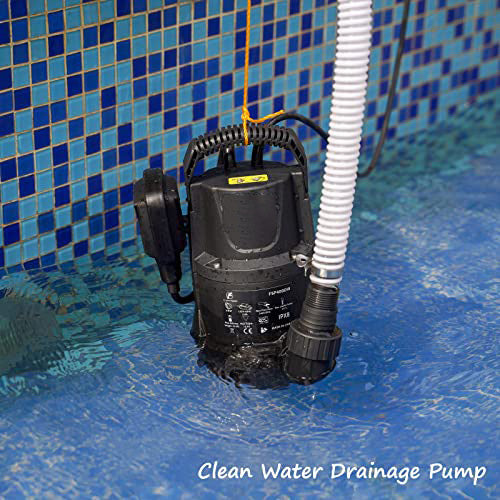The Guide to Properly Taking Care of a Sump Pump
The Guide to Properly Taking Care of a Sump Pump
Blog Article
We've stumbled on this post pertaining to Steps to Cleaning Your Sump Pump Properly down the page on the web and concluded it made sense to write about it with you on this site.

Sump pumps are vital elements in many homes, especially in areas vulnerable to flooding or extreme dampness. They aid avoid water damage by efficiently removing excess water from basements or crawl spaces. Nevertheless, like any other device, sump pumps need routine upkeep to guarantee they work efficiently when required the most. Cleansing your sump pump is a crucial part of its upkeep, and recognizing how to do it appropriately can save you from expensive repairs and prospective disasters.
Introduction
Preserving a clean sump pump is important for its appropriate functioning and longevity. Overlooking this necessary task can result in clogs, breakdowns, and inevitably, water damages to your property. Therefore, finding out exactly how to cleanse a sump pump is essential for home owners who depend on these devices to keep their cellars completely dry and protected.
Comprehending the Sump Pump
Before diving into the cleaning procedure, it's important to have a fundamental understanding of exactly how a sump pump functions. Commonly mounted in a pit or basin below the cellar flooring, a sump pump includes several crucial elements, consisting of a pump, a float switch, and a discharge pipe. When water gathers in the pit, the float switch turns on the pump, which then pumps the water out via the discharge pipe, far from the structure's foundation.
Indications of a Dirty Sump Pump
Understanding when your sump pump requires cleansing is vital for preventing prospective malfunctions. Some usual indications that show an unclean sump pump include odd noises throughout procedure, lowered water flow, and visible debris in the pit. If you see any one of these symptoms, it's essential to clean your sump pump quickly to prevent any kind of more issues.
Getting ready for Cleansing
Prior to you start cleaning your sump pump, it's necessary to take some safety and security precautions. Start by shutting down the power to the pump to prevent any type of electrical crashes. Additionally, use ideal protective equipment, such as gloves and safety glasses, to secure yourself from dust, debris, and possible pathogens.
Step-by-step Guide to Cleaning Up a Sump Pump
Turning off the Power
Begin by detaching the power supply to the sump pump to avoid any kind of accidents while cleansing.
Eliminating Particles and Dust
Utilize a bucket or an inside story to eliminate any visible particles, dust, or debris from the sump pit. Dispose of the debris appropriately to avoid it from obstructing the pump or the discharge pipe.
Cleansing the Pump and Drift Change
When the pit is clear of debris, carefully remove the pump from the pit. Inspect the pump and the float switch for any type of indications of damage or wear. Make use of a soft brush or cloth to cleanse the surfaces and get rid of any gathered grime.
Purging the System
After cleaning the pump and float switch, flush the sump pit with clean water to eliminate any remaining dirt or debris. This will help make sure that the pump operates smoothly and successfully.
Looking For Appropriate Performance
Prior to reinstalling the pump, carry out a quick examination to ensure that the float switch turns on the pump appropriately. Pour some water right into the sump pit and observe the pump's operation. If everything is working correctly, you can rebuild the pump and reconnect the power supply.
Upkeep Tips to Keep Your Sump Pump Clean
Along with periodic cleansing, there are a number of maintenance ideas you can comply with to keep your sump pump in optimal problem:
Verdict
Cleansing your sump pump is a critical aspect of its upkeep and makes certain that it runs efficiently when you require it one of the most. By following the actions laid out in this guide and incorporating regular upkeep into your regimen, you can extend the life expectancy of your sump pump and secure your home from water damage.
6 STEPS ON HOW TO CLEAN A SUMP PUMP PROPERLY
UNDERSTANDING SUMP PUMPS
Your sump pump plays a crucial role in protecting your home by managing and removing excess water. It primarily functions as a “shield”, guarding your basement against the damaging effects of water accumulation. The pump is housed in a sump pit in the lowest part of your basement, and its job is to pump out any water that collects there.
During heavy rainfalls or when snow melts rapidly, water can infiltrate your basement, posing potential risks like flooding, structural damage, and harmful mold growth. Here, the sump pump springs into action, pumping out the intruding water and directing it away from your home.
SAFETY FIRST
Before cleaning, remember to prioritize safety. Disconnect the sump pump from the power source to prevent any accidental electric shocks. Also, wear sturdy gloves to protect your hands from any sharp or dirty components within the pump.
REMOVE THE SUMP PUMP
After ensuring your safety, the next step is to remove the sump pump from its pit. Doing this might require careful maneuvering as you don’t want to damage any pump components. Once removed, clean the sump pit to remove any accumulated debris or sludge.
INSPECT THE PUMP
Inspect the pump for any visible signs of wear or damage. Check the power cord, float switch, and impeller housing. If any components look worn out or damaged, consider replacing them to ensure optimal performance.
CLEAN THE PUMP
Thoroughly clean the pump with warm, soapy water. Make sure to rid it of any dirt, gravel, or other debris that might impede its performance. You can use a toothbrush to clean the small, hard-to-reach parts of the pump.
REINSTALL THE SUMP PUMP
Reinstall the pump into the sump pit Make sure it’s positioned correctly to remove the water effectively Once it’s back in place, reconnect it to the power source TEST THE PUMP
Finally, pour some water into the pit to ensure the pump works correctly. It should start automatically and begin pumping out the water; if it doesn’t, check the power source and the positioning of the pump.
Remember, while cleaning your sump pump is an essential part of home maintenance, hiring a professional plumber for a thorough inspection and cleaning at least once a year is also important. This will ensure that your pump is in optimal condition, ready to protect your home from potential water damage.
BEST PRACTICES FOR CLEANING SUMP PUMP DISCHARGE PIPES
Regular Inspection: Regularly inspect your discharge pipes, especially during heavy rainfall or snowmelt periods. Look for any signs of blockage or damage. Early detection of problems can prevent serious issues down the line. Periodic Cleaning: Over time, sediment and debris can accumulate in the discharge pipes, impeding the flow of water. Regular cleaning helps keep the pipes clear and functioning efficiently. You can use a high-pressure water jet to effectively clean the pipes. Insulation During Winter: In colder climates, discharge pipes can freeze, blocking the outflow of water. Protect your discharge pipes from freezing temperatures by insulating them with foam pipe insulation. This will ensure the sump pump can continue to discharge water even in freezing conditions. Proper Positioning: The discharge pipe should be positioned to direct water away from your home’s foundation. Improper positioning can lead to water seeping back into the basement. Ensure the pipe is long enough and angled correctly. Installation of a Check Valve: A check valve prevents water from flowing back into your sump pit after the pump has pushed it out. Installing a check valve helps maintain the efficiency of your sump pump and reduces the risk of flooding. Minimize Pipe Turns: Every curve or turn in the discharge pipe can decrease the efficiency of water flow. By minimizing turns and bends in your discharge pipe, you can increase the efficiency of your sump pump. https://www.fullspeedplumbing.com/how-to-clean-a-sump-pump-properly9999/

I ran across that piece of writing on Steps to Cleaning Your Sump Pump Properly while doing a lookup on the web. Appreciated our review? Please share it. Help someone else locate it. Thank you for taking the time to read it.
Explore Report this page